PC Power & Cooling Silencer 750 Quad CF-Edition
by Christoph Katzer on July 18, 2007 1:00 AM EST- Posted in
- Cases/Cooling/PSUs
Temperatures (Ambient 25-50°C)
We feel it is important to show what each power supply is truly capable of providing. The easiest way to separate the cream of the crop from inferior quality is to let the power supplies run in a very hot environment. Cheap components give up quickly and under stress conditions we can force lesser power supplies to fail. Good components will withstand the tremendous heat and keep on running. With increasing heat we will see the voltage of each rail dropping. This is a normal response from the components since they cannot deliver the same performance with increasing temperatures.
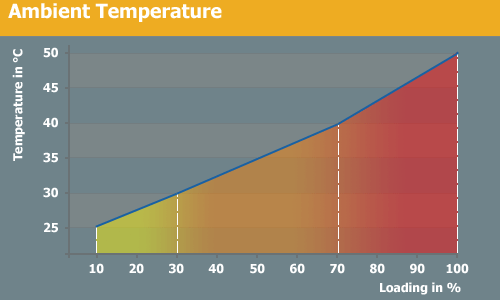
To heat up a box to 50°C you don't necessarily need a thermal chamber. For our tests we are using a natural circumstance. Our acoustic testing box is well isolated and will heat up with the running power supply inside. While this will not give us accuracy to a tenth of a degree, we can get a very good result for our use. To help the chamber heat up, we installed high wattage light-bulbs. If the temperature gets too high we cool it down with fresh air from outside. In this way we keep the same temperature for the different loads on each unit.
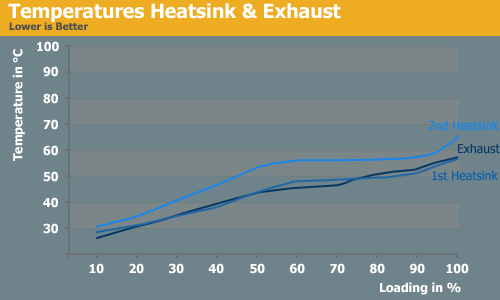
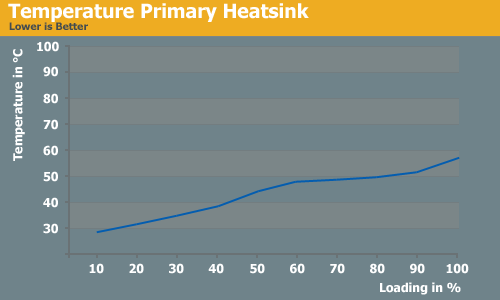
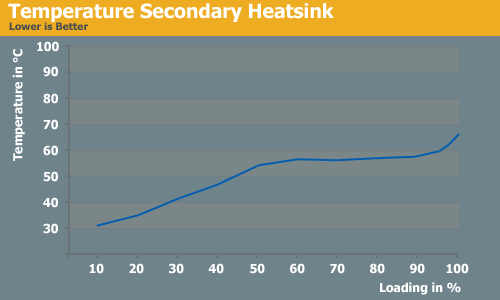
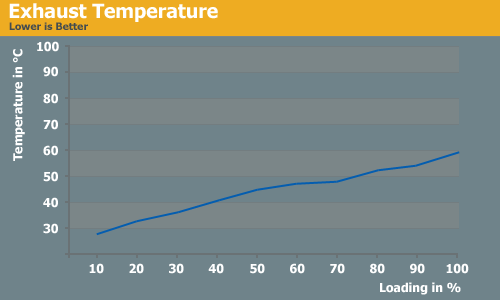
Under higher ambient temperature the heatsinks show similarities to room temperature. They get progressively warmer but the results are almost parallel to each other. The exhausted temperature is generally close to that of the primary heatsink. In comparison with the OP650 the secondary heatsink of the Silencer is much bigger in size. With the bigger size it has an increased capacity and better ability to transfer the heat into the air. The heatsink becomes cooler and can therefore cool components attached to it better.
We feel it is important to show what each power supply is truly capable of providing. The easiest way to separate the cream of the crop from inferior quality is to let the power supplies run in a very hot environment. Cheap components give up quickly and under stress conditions we can force lesser power supplies to fail. Good components will withstand the tremendous heat and keep on running. With increasing heat we will see the voltage of each rail dropping. This is a normal response from the components since they cannot deliver the same performance with increasing temperatures.

To heat up a box to 50°C you don't necessarily need a thermal chamber. For our tests we are using a natural circumstance. Our acoustic testing box is well isolated and will heat up with the running power supply inside. While this will not give us accuracy to a tenth of a degree, we can get a very good result for our use. To help the chamber heat up, we installed high wattage light-bulbs. If the temperature gets too high we cool it down with fresh air from outside. In this way we keep the same temperature for the different loads on each unit.




Under higher ambient temperature the heatsinks show similarities to room temperature. They get progressively warmer but the results are almost parallel to each other. The exhausted temperature is generally close to that of the primary heatsink. In comparison with the OP650 the secondary heatsink of the Silencer is much bigger in size. With the bigger size it has an increased capacity and better ability to transfer the heat into the air. The heatsink becomes cooler and can therefore cool components attached to it better.










31 Comments
View All Comments
strikeback03 - Wednesday, July 18, 2007 - link
Enermax Liberty 400W - tag says up to 20A per +12V rail or 30A between them.
And frankly, if they had started with reviews of a couple 400-500W power supplies, people probably would have been asking "Where is the review of the (insert favorite big power supply here)? Which is pretty much what happened with the CPU cooler tests.
MageXX9 - Wednesday, July 18, 2007 - link
I agree...We need to give these guys more time to review more power supplies.On another note, while I enjoy reading a 17 page power supply review, more often than not I don't have the time or energy needed to digest the entire article. Most times I read the first page, and then skip directly to the last. What I would really like to see, and think would be most beneficial to everyone interested in power supply articles, is something along the lines of a "leader board".
The "leader board" could have different classes such as 400W - 600W, and possibly an article describing how to properly rate your components. Learning how to accurately calculate the range of power needed for your system will prevent novices from buying a 750W power supply for a system that only needs 500W. While the 750W will work, it will not perform as well as a lesser wattage power supply ran at 70%.
The reason I think this would help is I build systems for myself, friends, or family and if I'm not up on the reviews then I have to wade through countless power supply reviews. It'd be nice to think, "I need something in the 400W - 600W range, what is the best". The leaderboard could show what's the best, and could also contain a personal reccommendation from the reviewer that takes into account other factors such as price/performance, asthetics, build quality, warranty, etc.
I'm not so sure a "leaderboard" for other components is needed since other components are made to work together. I know there is "Anand's picks" on the front page, but it says nothing about power supplies, cases, monitors....etc.
I'm just thinking out loud...any opinions?
Christoph Katzer - Wednesday, July 18, 2007 - link
It sounds very interesting and I was already thinking about a monthly pick for example. Just an article which compares all PSUs tested the past month.I am not a fan of high performance PSUs myself. I am trying to get more lower performing ones but it's difficult since the companies want to send in their highest models. I already chose smaller/st models for the tests (Enermax Infiniti 650, Liberty 500, Seasonic 380/400 etc).
mostlyprudent - Wednesday, July 18, 2007 - link
If I recall correctly, the "Anandetch PSU Test Methodology" article went so far to say that many users by PSU for in excess of their needs and that an 800 watt PSU is often less efficient at outputting lower wattage levels.I am hoping that once they get some more reviews up they will start delineating the kind of system each PSU would be appropriate for (i.e., SLI + Qaudcore) and start making some recomendations for difference wattage ranges.
sc3252 - Wednesday, July 18, 2007 - link
I don't know anyone who uses these type of power supplies, and I am getting sick of all the top of the line power supply reviews. I am not just talking about this website, but hardocp seems to think a $120 power supply is mainstream too. Can you guys please review something we can buy(cough cough, college students).Disclaimer, i didn't read the review, and I don't even care to. This is something I wont buy, and I dont know anyone else that is going to be buying a power supply like it or that will need it.
mostlyprudent - Wednesday, July 18, 2007 - link
Unless and until they review every PSU on the planet, some of us will always want more. I have bought my share of $40 PSUs with mixed results. Overall, I have come to believe that the PSU is one of the componants you should not skimp on.Having said that, I think wattage (more than price) is something I hope Anandtech covers with greater breadth. I will be disappointed if the majority of the PSU reviews are of 700+ watt PSUs.
I think the conventional wisdom is often that if brand XYZ makes a great 800 watt PSU, then their 450 watt PSU must also be great. This thinking seems to hold true across other product lines as well. I really hope Anandtech will test the validity of that thinking with respect to PSUs.
pervisanathema - Wednesday, July 18, 2007 - link
You have made the common mistake of assuming that your personal experiences with money apply to everyone else outside of your peer group.It is quite obvious that these types of PSUs are selling briskly or manufacturers would stop making them instead of introducing new ones.
michal1980 - Wednesday, July 18, 2007 - link
I agree with the budget guy.people are looking to buy the cheapest CPU and overclock it, but then spend the big bucks on Motherboards/Ram/Powersupply.
almost might be cheaper to buy a higher end cpu at a speed you know you will get and just get good middle of the road ram/psu/mobo. And you have the benefit of knowing it will work at that speed, not crossing your fingers
Alyx - Wednesday, July 18, 2007 - link
If the extra inch or so between fan and components does not help with noise I wonder if it helps with cooling. Possibly creating a move even flow of air over the two heatsinks, and also negating the dead spot in the center of the fan.Good review, I'm really interested in these. It will be really nice in a few months once you have a good base of power supplies to compare too. Hopefully you will update the chart on the last page of the review as you go along.
Sgraffite - Wednesday, July 18, 2007 - link
The efficiency graphs on page eleven state "lower is better", when I'm pretty sure it should say higher is better :)